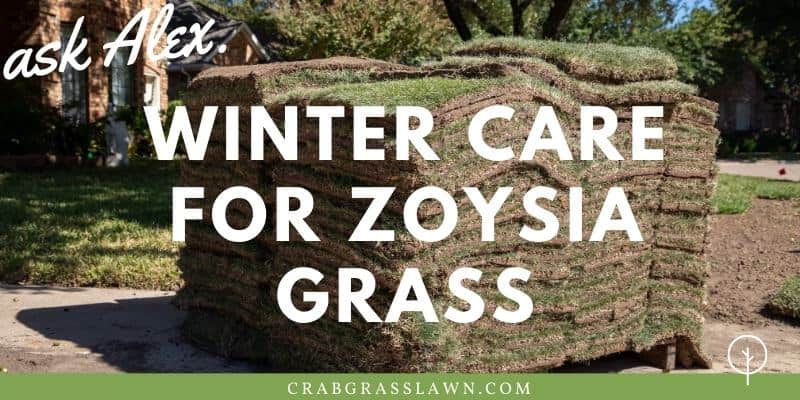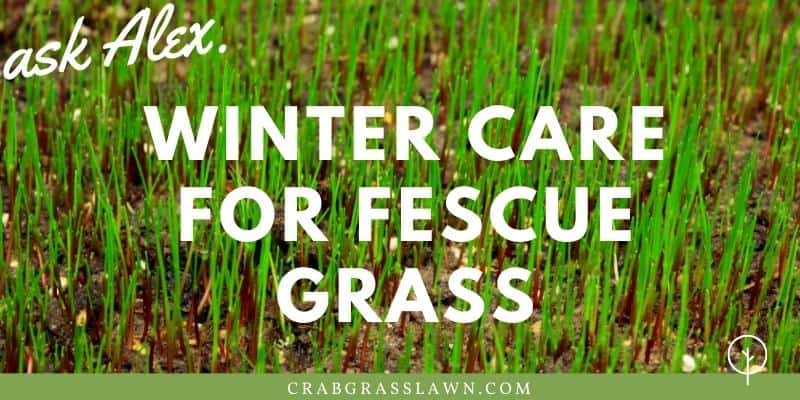I’ve usually found it a bit challenging trying to determine how short to cut grass before winter because there are several factors to consider including the type of turfgrass. A cool factoid about grass is that it never stops growing, even in the winter!
- Warm-season grasses can be cut slightly shorter, typically around 1.5 to 2.5 inches before winter.
- For cool-season grasses, I recommended leaving the grass at a height of about 2.5 to 3 inches before winter.
In this article, I’ll go over the suggested winter cutting heights for Bermuda, St. Augustine, Zoysia, and Fescue.
Winter Care for Bermuda Grass

Bermuda grass is typically found in traditional and southern zones and has many quality traits including a dense, medium-fine texture, great heat and drought tolerance, and speedy establishment and growth rate.
But on the flip side, this perennial warm-season grass has a low tolerance for temperatures and shades, owing to which it goes dormant, and does not die in the winter months i.e. if you’ve treated it right.
Bermuda grass winter lawn care requires less effort compared to spring and summer months and can be done in a few easy steps.
How Short To Cut Bermuda Grass Before Winter?
Bermuda grass lawns should be mowed to roughly 1 – 1 1/2 inches high during its growing period, and again to this height when it grows to about 2 and 2 1/2 inches tall in the fall.
Even though you don’t have to mow Bermuda grass in the dormant months, you should trim the edges and uneven spots occasionally. And because Bermuda grass is no longer growing when dormant, you will not have to perform any regular maintenance.
You should however water your Bermuda grass turf occasionally to prevent desiccation, especially when the weather is warm and windy. And once the period of environmental stress ends, your Bermuda grass lawn will turn green again.
If you’ve overseeded Bermuda grass with ryegrass, mow your lawn to roughly 1 inch, and leave the clippings on the surface to help recycle the nutrients. Cutting Bermuda grass any shorter than this can increase its chances of cold weather damage. Did you know that overseeding can help rejuvenate thin and bare spots in your lawn?
Overseeding Bermuda Grass for the Winter
Lawn owners who prefer green Bermuda grass throughout the winter can choose to overseed dormant Bermuda grass for year-round green color, but there are pros and cons to this approach.
Overseeding Bermuda grass in the winter means continuous work throughout the season, and is not recommended for immature turf that is less than six to eight months of age after planting.
On a brighter note, allowing Bermuda grass to go dormant means minimal maintenance and water usage.
For overseeding a Bermuda grass lawn, you can use one of two species — annual ryegrass or perennial ryegrass. Once the temperatures surge in the spring, the ryegrass will die, making way for the return of the Bermuda grass.
Fertilizing Bermuda Grass in the Winter
Fertilizing your Bermuda grass lawn should ideally be done before it goes dormant and again around April, and in December and February if you’ve overseeded.
It is however highly important to refrain from fertilizing Bermuda grass during the winter, as doing so may trigger your lawn to break its dormancy.
Giving Bermuda grass a rich dose of fertilization with either organic or inorganic fertilizer before dormancy replenishes the nutrient content in the soil that was lost during the extremely hot summer. When winter strikes, the soil will soak up the fertilizer, and feed your Bermuda grass roots throughout the winter.
Winter Care for St. Augustine Grass

St. Augustine is a robust, and one of the best-performing warm-season grasses, and just like Bermuda grass goes dormant in the winter. It does however stay green all year round in soil temperatures that are warmer than 60 degrees.
This perennial warm-season grass has a higher weather tolerance than Bermuda grass but requires more maintenance in terms of water consumption and regular mowing.
During its dormancy, some St. Augustine grass types naturally lose their green color and brown off, but you may still need to water them periodically when the weather is a bit warm and dry.
The amount of daily sunlight reduces as winter approaches, resulting in the inability of St. Augustine grass to photosynthesize its food.
How Short To Cut St. Augustine Grass Before Winter?
To encourage photosynthesis, and maintain St. Augustine grass in the winter, you should raise the mower height to ½ to 1 inch before and once during the winter season to aid in keeping the lawn leaf green throughout the winter.
If you’ve been watering your St. Augustine turf periodically, it is more likely to come back green, so you don’t have to short-mow your turf before winter.
St. Augustine grass will die if it doesn’t receive the appropriate amount of moisture, but watering it regularly will keep the roots healthy, and help it become green again in the spring.
Overseeding St. Augustine Grass
St. Augustine grass is less tolerant to overseeding and plays hard to make good seed contact with cool-season grass seeds. If you do overseed St. Augustine grass, you will end up scalping or causing irreparable damage to your lawn.
And since scalping is not recommended for warm-season turfgrasses before winter dormancy, it may be beneficial in late winter to early spring. These perks include controlling certain winter annual broadleaf weeds, and removal of some debris that could trigger thatch accumulation.
Fertilizing St Augustine Grass in the Winter
By applying a good quality winter fertilizer in the fall months, you can prevent extensive browning of St. Augustine grass at the onset of winter.
There are two ways of applying fertilizer to a St. Augustine lawn — the first is applying a standard winter fertilizer before the winter sets in, and a reapplication of the same fertilizer a few months into the season.
The second option is to apply a slow-release fertilizer before winter, which will act slowly to help your grass retain its beautiful green color, and last throughout the entire winter season.
Winter Care for Zoysia Grass

Unlike Bermuda grass lawns, Zoysia warm-season turf grass often does not go fully dormant during winter. It does however turn golden brown when dormancy kicks in, but stays greener much longer than St. Augustine and Bermuda grass.
Zoysia grass is also drought tolerant, hardy, and fairly self-sufficient, so ideally the best way to maintain it during the winter months is to keep it healthy during the growing season.
These maintenance steps include mowing at the proper height, dethatching the lawn in June, fertilizing, and watering to a depth of 6 – 8 inches.
How Short To Cut Zoysia Grass Before Winter?
Mow your Zoysia turf before it grows higher than 11⁄2 to 21⁄2inches using a rotary or reel mower set as low as possible, otherwise, you risk scalping your lawn. This should be done before dormancy kicks in, somewhere between September to November.
The nutrient-rich grass clippings resulting from the Zoysia winter short mow should be left on the lawn unless they affect the overall appeal of your turf. You will need to water the lawn once it has gone dormant, but only when the soil is powder dry.
Overseeding Zoysia Grass
Take a good look at your lawn first to make sure it is healthy before deciding to overseed Zoysia grass. Overseeding Zoysia turf during the fall can thicken your lawn, and add some green color during the winter months.
Ryegrass and tall fescue are a common choice for overseeding Zoysia grass and grow fairly quickly. But ryegrass and tall fescue also compete with your established Zoysia grass turf for water and essential nutrients, so overseeding may cause more harm than good.
Fertilizing Zoysia Grass in the Winter
Fertilizing Zoysia grass in the winter is not a good idea, as it could stimulate the grass, and cause it to end its dormancy period. If you’re going to fertilize your Zoysia grass lawn, you risk damaging it in the next wave of freezing temperatures.
Winter Care for Fescue

Fescue is a heat-tolerant, low-maintenance cool-season turfgrass that stays green until temperatures drop below 50 degrees F consistently, resulting in poor growth due to dormancy.
Unlike its warm-season grass counterparts that brown off in the winter, fescue stays green, and does better in cooler climates than in warm ones. However, the common misconception is that winter is the most favorable time for fescue, and summer the worst, but this cool-season grass prefers chilly springs and falls as its ideal thriving conditions.
As a result, it does survive the extremes of winter much better summer but still goes into a natural state of dormancy during the winter months. During this brief period of dormancy, fescue stops growth, but its roots continue to grow, and store nutrients to combat next year’s summer.
How Short to Cut Fescue Before Winter?
Fescue should be mowed during warm temperatures at no lower than three inches. Mowing any higher than this reduces heat and drought stress by decreasing Fescue’s natural defense mechanism. Further, mowing higher also reduces the water consumption of Fescue, allowing the grass to stay greener longer.
Overseeding Fescue
Because Fescue is a cool-season grass, fall seeding in September is an ideal time to establish a Fescue lawn. You should ideally sprinkle grass seed roughly three weeks before the first frost of the season.
This gives the seeds the right amount of time they need to germinate and establish roots before winter arrives. Overseeding Fescue in the late summer/early autumn can help prevent competition from weedy grasses such as foxtails, crabgrass, etc.
Fertilizing Fescue in the Winter
Given that Fescue lawns thrive in cooler climates, they do respond quickly to a steady amount of fertilizer in the spring or fall. However, it is worth noting that applying excessive fertilizer won’t necessarily make your Fescue greener, but will make the grass grow faster, and require more mowing.
Why You Should Cut Your Grass Before Winter?
Your lawn needs a little bit of TLC during the colder months of the year for several reasons. Unless you’re lucky enough to reside in an area that’s warm all year round or use a grass type that does not require mowing, you will have to prepare your lawn properly, so that it can survive through even the harshest winter, and still be lush when spring rolls around.
One of the most important things to do is to cut your grass short before the first freeze, but this is a task that is easier said than done, and here’s why! If you cut the grass too short, your lawn may be prone to winter freeze-burn over the winter months. This can cause long-term damage, particularly in extremely cold and dry weather conditions.
Contrarily, cutting your grass too long – four inches or more can cause it to lay over and become matted to the ground along with a layer of snow. If left in this condition for longer periods, you may be risking several fungal diseases called pink mold or snow mold.
The only solution to this is to cut it to the right height at the right time and with sharp blades. But the tricky part is determining the exact height to cut your grass, because different grass species and varieties may call for different conditions. We break down the most popular grass types below.
FAQs
What Is the Latest Time to Mow the Lawn?
If you’re referring to new sod, you should wait at least 2 to 3 weeks after installation to cut the grass. The sod will begin to grow strong roots during this time, after which you can cut the grass no more than one-third of the grass height.
With regards to time, the latest time to mow the lawn is 10 am as it gives the water time to evaporate during the day.
Is It Better to Leave Your Lawn Long or Short for Winter?
I recommend always maintaining a grass height between 2 inches and 2.5 inches, which is the ideal height for grass to resist disease but not too short to become stressed by cold temperatures.
Grass height matters regardless of the season and apart from the health factor, influences the curb appeal of your lawn. It is worth noting that grass stops growing once the temperature drops below 10 degrees Celsius so pay attention to the weather to cut grass for the last time before the first frost.
What Temperature Is Too Cold to Mow Grass?
Temperatures below 50 degrees Fahrenheit are considered too cold to mow the lawn. The ideal temperatures to cut grass are between 50 to 80 degrees Fahrenheit.
Final Thoughts
Cutting grass shorter in winter offers myriad long-term benefits for your lawn, most notably increasing its ability to resist extreme winter temperatures. The cutting height and time to short mow in winter vary across grasses because cutting too high may increase the grass’s tendency to mat under snowfall and invite diseases such as snow mold.
You also don’t want to cut the grass too short because this will trigger the grass to use more nutrients to regain its missing height.
All in all, you should short-mow your lawn before the first freeze to help it survive the harshest winter months. The general rule of thumb is to avoid mowing more than one-third of the total grass blade length at one time.
References:
You May Also Like…
End of Winter Care for Lawn – 8 Tips to Foster a Lush Lawn
Hi, Alex Kuritz here. Growing up I remember that my family had one of the best lawns in the neighborhood. Richly green and lush. I did a lot as I grew up in terms of caring and tending for not only my family’s lawn but also my neighbors. I can say I have years of experience, and I am here to share it with you.


